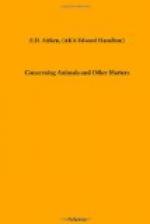Swinges the scaly horror of his folded tail,
and the raging lion of fiction lashes its sides with the same nervous instrument.
It would be tedious to dwell on the pretty part which the tail plays in the courtships of sparrows and pigeons, or on the sprightly attitudes by which birds of all sorts let off their spirits when shower and sunshine have overfilled their hearts with gladness. But birds twitch their tails constantly, without meaning anything by it. The ceaseless wagging of a wagtail is a mere habit of cheerfulness, like the twirling of her thumbs by an idle Scotswoman. The long tail is there and something must be done with it. Look at the embarrassment which a nervous young man shows about the disposal of his hands; how he thrusts them into his trouser pockets, hangs them by their thumbs from the arm-holes of his waistcoat, or gives them a walking-stick to play with. I like to imagine what such a fellow would do with a long tail if he had it—how he would wind it round each leg in turn, rub up his back hair, and describe figures on the floor. But no animal so self-conscious as man could bear up long under the nervous strain of having to think continually of its tail. It would die young and the race would become extinct. Perhaps it did.
A final word on the conclusion of the whole matter, for these reflections have a moral. As habit becomes character, so expression hardens into feature. The tail of a sheep grows downwards, but that of a goat upwards, and this is the only infallible outward mark of distinction between the two animals. But it is the permanent record of a long history. The sheep was never anything but sheepish; the goat and its forefathers were pert as kids and insolent when their beards grew. It is useless to inquire why insolence should express itself by an upturned tail until someone can advance a reason why it should express itself in another way.
For proof of the fact you need go no farther than your own dogs. The ancestral wolf, or jackal, hunting and fighting, fearing and hoping, showed every changing mood by the pose of its tail; but a change came when it acquired an assured position of security and importance as the chosen companion of man, so dreaded by all its kith and kin. The tail went up at once and stayed there; when it could go no higher, it curled over. But promotion breeds conceit only in base natures. The greyhound is a gentleman, respectful and self-respecting, and it shows that by the very carriage of its tail. Only a snob at heart, petted and pampered for many generations, could have produced that perfect incarnation of smug self-satisfaction, the pug. Let us take the lesson home. The thoughts on which we let our minds dwell, and the sentiments that we harbour in our hearts, are the chisels with which we are carving out our faces and those of our children’s children.




